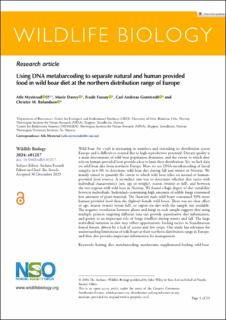| dc.contributor.author | Mysterud, Atle | |
| dc.contributor.author | Davey, Marie Louise | |
| dc.contributor.author | Fossøy, Frode | |
| dc.contributor.author | Grøntvedt, Carl Andreas | |
| dc.contributor.author | Rolandsen, Christer Moe | |
| dc.date.accessioned | 2024-04-15T10:56:09Z | |
| dc.date.available | 2024-04-15T10:56:09Z | |
| dc.date.created | 2024-03-01T11:57:16Z | |
| dc.date.issued | 2024 | |
| dc.identifier.issn | 0909-6396 | |
| dc.identifier.uri | https://hdl.handle.net/11250/3126524 | |
| dc.description.abstract | Wild boar Sus scrofa is increasing in numbers and extending its distribution across Europe and is difficult to control due to high reproductive potential. Dietary quality is a main determinant of wild boar population dynamics, and the extent to which they rely on human-provided food provide a key to limit their distribution. Yet, we lack data on wild boar diet from northern Europe. Here we use DNA-metabarcoding of faecal samples (n = 50) to determine wild boar diet during fall and winter in Norway. We mainly aimed to quantify the extent to which wild boar relies on natural or human-provided food sources. A secondary aim was to determine whether diet varies with individual characteristics (sex, age or weight), season (winter or fall), and between the two regions with wild boar in Norway. We found a high degree of diet variability between individuals. Individuals consuming high amounts of edible fungi consumed low amounts of plant material. The (heavier) male wild boars consumed 50% more human provided food than the (lighter) female wild boars. There was no clear effect of age, season (winter versus fall), or region on diet with the sample size available. The negative correlation between plants and fungi in each sample suggests that using multiple primers targeting different taxa can provide quantitative diet information, and points to an important role of fungi (truffles) during winter and fall. The large individual variation in diet may reflect opportunistic feeding tactics in Scandinavian boreal forests, driven by a lack of acorns and few crops. Our study has relevance for understanding limitations of wild boars at their northern distribution range in Europe, and thus also provides important information for management. baiting, diet, metabarcoding, mushrooms, supplemental feeding, wild boar | |
| dc.language.iso | eng | |
| dc.title | Using DNA metabarcoding to separate natural and human provided food in wild boar diet at the northern distribution range of Europe | |
| dc.title.alternative | Using DNA metabarcoding to separate natural and human provided food in wild boar diet at the northern distribution range of Europe | |
| dc.type | Peer reviewed | |
| dc.type | Journal article | |
| dc.description.version | publishedVersion | |
| cristin.ispublished | true | |
| cristin.fulltext | original | |
| cristin.qualitycode | 1 | |
| dc.identifier.doi | 10.1002/wlb3.01217 | |
| dc.identifier.cristin | 2251280 | |
| dc.source.journal | Wildlife Biology | |
| dc.relation.project | Norges forskningsråd: 160022 | |
| dc.relation.project | Andre: Norwegian Environment Agency | |
| dc.relation.project | Andre: Norwegian Ministry of Agriculture and Food | |
| dc.subject.nsi | VDP::Genetikk og genomikk: 474 | |
| dc.subject.nsi | VDP::Genetics and genomics: 474 | |
